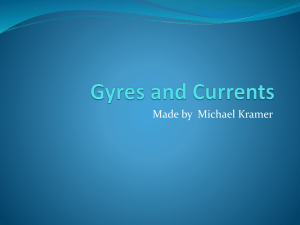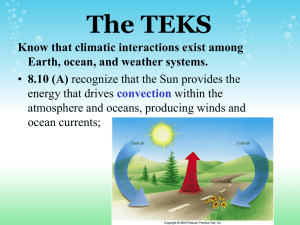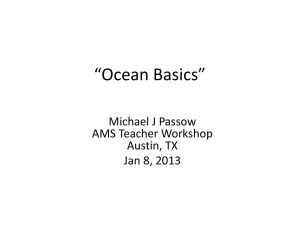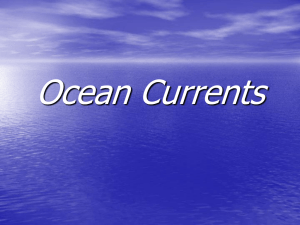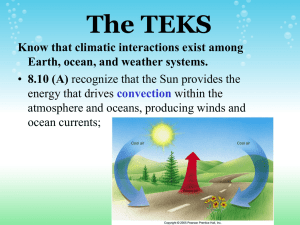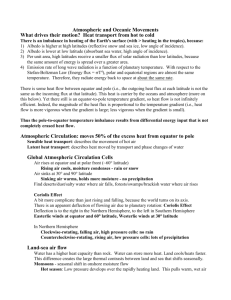lecture notes
advertisement
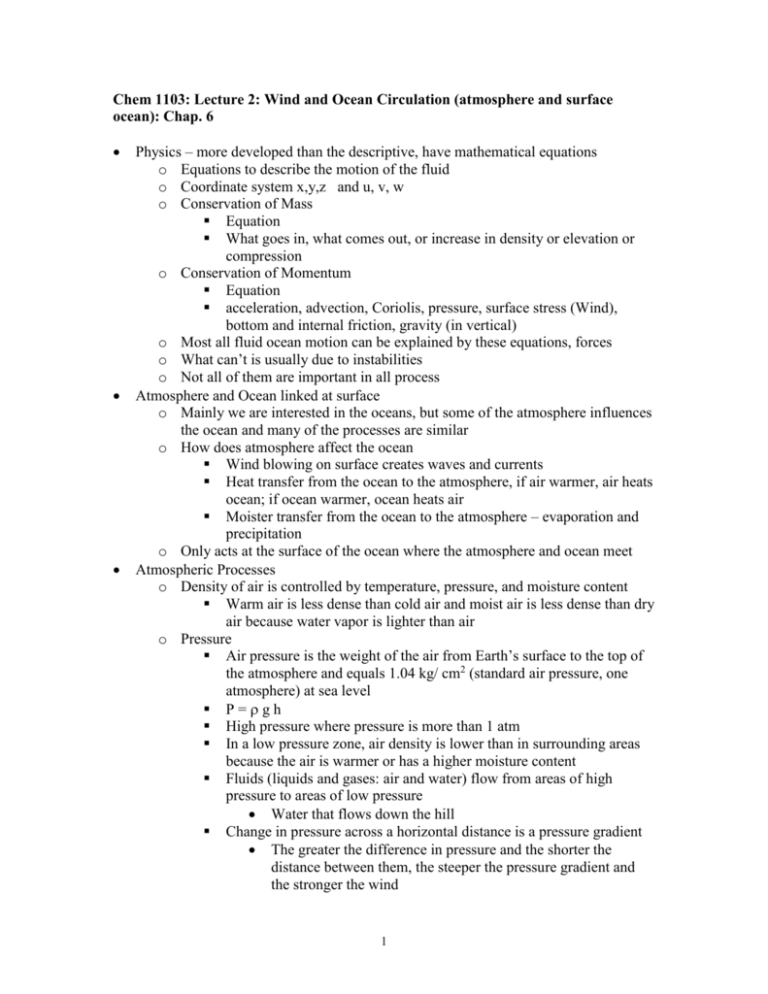
Chem 1103: Lecture 2: Wind and Ocean Circulation (atmosphere and surface ocean): Chap. 6 Physics – more developed than the descriptive, have mathematical equations o Equations to describe the motion of the fluid o Coordinate system x,y,z and u, v, w o Conservation of Mass Equation What goes in, what comes out, or increase in density or elevation or compression o Conservation of Momentum Equation acceleration, advection, Coriolis, pressure, surface stress (Wind), bottom and internal friction, gravity (in vertical) o Most all fluid ocean motion can be explained by these equations, forces o What can’t is usually due to instabilities o Not all of them are important in all process Atmosphere and Ocean linked at surface o Mainly we are interested in the oceans, but some of the atmosphere influences the ocean and many of the processes are similar o How does atmosphere affect the ocean Wind blowing on surface creates waves and currents Heat transfer from the ocean to the atmosphere, if air warmer, air heats ocean; if ocean warmer, ocean heats air Moister transfer from the ocean to the atmosphere – evaporation and precipitation o Only acts at the surface of the ocean where the atmosphere and ocean meet Atmospheric Processes o Density of air is controlled by temperature, pressure, and moisture content Warm air is less dense than cold air and moist air is less dense than dry air because water vapor is lighter than air o Pressure Air pressure is the weight of the air from Earth’s surface to the top of the atmosphere and equals 1.04 kg/ cm2 (standard air pressure, one atmosphere) at sea level P=gh High pressure where pressure is more than 1 atm In a low pressure zone, air density is lower than in surrounding areas because the air is warmer or has a higher moisture content Fluids (liquids and gases: air and water) flow from areas of high pressure to areas of low pressure Water that flows down the hill Change in pressure across a horizontal distance is a pressure gradient The greater the difference in pressure and the shorter the distance between them, the steeper the pressure gradient and the stronger the wind 1 o Wind response to pressure Global winds blow in response to variation in pressure related to uneven solar heating (insolation) of Earth’s surface Equatorial low pressure occurs because intense heating and high moisture content makes the air less dense. Rising air produces a convergence at the surface into which the air flows and rises Polar high pressure occurs as cold, dry dense air sinks to the surface and flows outward forming an area of divergence Convergence and divergence - explain Winds from North are northerly, currents from South are northerly Difference between meteorology and oceanography, but need to understand to understand weather forecasts and currents – know that they are different But the winds here don’t flow from the North, mostly they flow from the West – so this hypothesis fails to describe winds o Rotation of the Earth strongly influences winds Coriolis deflection is the apparent deflection of objects moving across Earth’s surface to the right of the direction of travel in the northern hemisphere and to the left of the direction of travel in the southern hemisphere Applies to objects moving relative to the Earth – air or water Use merry-go-round and airplane examples The deflection is caused by the differential speed of rotation between the Earth’s equator and polar regions, relative to an object moving across the Earth’s surface Coriolis deflection increases poleward and as speed increases f = 2 sin = rotation of earth = 7.292E-5 s-1 = latitude Falkland War – British missed by a mile Flow goes around the hill Example of weather o Three major convection cells are present in each hemisphere Zonal wind flow is wind moving nearly parallel to latitude as a result of Coriolis deflection The Hadley cell extends from the Equator to about 30o latitude At the equator, warm moist air expands, becomes less dense, and rises forming a zone of low pressure called the doldrums As the air continues to rise, it cools and most of its moisture condenses and falls as tropical rainfall At high altitude the air flows poleward, becoming cooler and denser, until it sinks to Earth’s surface at about 30o latitude, forming a high pressure zone called the horse latitudes 2 Most of this air flows southward, as the Coriolis-deflected trade winds, gradually warming and absorbing moisture. As the air approaches the equator it again rises and is recycled. The Ferrel Cell extends from 30o to about 50o latitude. Some of the air descending at 30o latitude flows poleward as the Coriolis-deflected westerlies to about 50o where they encounter cold, dense air moving equatorward from the poles. The less dense warmer air is forced up over the denser cold air at the polar front and much of it flows equatorward at high altitude to about 30o where it enters the horse latitudes. The Polar Cell extends from 90o to about 50o latitude Some air from the polar front travels poleward becoming cold and dry At the pole the air descends, forming a polar high pressure zone, and flows outward as the Coriolis-deflected polar easterlies which eventually collide with the westerlies at the polar front Explain the wind figure of the Earth and the weather chart o Other forces Advection – movement of water – carrying things along Diffusion Friction – slowing down of flow Convection – heat rising, cold sinking BREAK Surface Ocean Currents – Oceanography now o Remember ocean is 3 layers o For currents, we are looking at average over years, not day to day, occasionally some seasonal o Wind-driven currents are produced by the interaction between the wind and the water As wind moves across the water, collision of air molecules with water molecules inefficiently transfer energy from the air to the water causes waves and currents Westerly-driven ocean currents in the trade winds, easterly-driven ocean currents in the Westerlies and deflection of the ocean currents by the continents results in a circular current, called a gyre, which occupies most of the ocean basin in each hemisphere o Pressure gradients develop in the ocean because the sea surface is warped into broad mounds and depressions with a relief of about one meter Mounds are caused by convergences, places where water flows together and sinks Depressions are caused by divergences, places from where water rises to the surface and flows outward 3 Water flowing down pressure gradients on the ocean’s irregular surface are deflected by Coriolis and the amount of deflection is a function of location and speed So this is pressure and Coriolis that are important o With time, wind-driven surface water motion extends downward into the water column, but speed decreases and direction changes because of Coriolis deflection Eckman spiral is the spiraling pattern described by changes in water direction and speed with depth Eckman transport is the net transport of water by wind-induced motion Net transport of the water in an Eckman spiral has a Coriolis deflection of 90o to the direction of the wind Along the coastal areas Eckman transport can induce downwelling or upwelling by driving water towards or away from the coast, respectively Upwelling is when near shore surface water is driven seaward resulting in deeper water being pulled to the surface o Upwelling also occurs between gyres Downwelling is when near shore surface water is landwand and its accumulation depresses the deep water o Downwelling also occurs in the center of the gyre o Langmuir circulation is a complex horizontal helical (spiral) motion that extends parallel to the wind – Adjacent helices rotate in opposite directions creating alternating zones of convergence and divergence Material floating on the surface becomes concentrated in the zones of convergence and forms sea stripes which parallel the wind o Geostrophic flow allows currents to flow long distances with no apparent Coriolis deflection - Coriolis and Pressure Coriolis deflects water into the center of the gyres, forming a low mound As the height of the mound increases, the pressure gradient steepens, pushing the water outward in an attempt to level the mound When the pressure gradient equals Coriolis deflections, the current flows parallel to the wind around the mound as a geostrophic current and this is called geostrophic flow Gyres in the northern hemisphere rotate clockwise and in the southern hemisphere counterclockwise The current flow pattern in gyres is asymmetrical with narrow, deep and swift currents along the basin’s western edge and broad, shallow slower currents along the basin’s eastern edge Western boundary current intensification is the squeezing of the western boundary current between a continent and the mound of water in the gyre, forcing the current to flow faster, deeper, and narrower 4 o The geostrophic mound is deflected to the western part of the ocean basin because of the eastward rotation of the Earth on its axis This creates a steeper slope on the western side of the mound because more water is being forced into the mound by the greater deflection from the faster flowing current o The Sargasso Sea is a large lens of warm water enriched by the North Atlantic gyre and separated from cold waters below and laterally by a strong thermocline o Western boundary currents, such as the Gulf Stream, form an meandering boundary separating coastal waters from warmer waters in the gyre’s center Western intensification – due to variation in Coriolis with latitude Meanders of the current can break free and form rings, large swirling migrating eddies, hundreds of kilometers in diameter and kilometers thick. They can last for years until they are reabsorbed into the gyres. Warm-core rings are those, which enclose a mass of warmer water compared to the body of water in which they are located. END Lab Lecture Labs 1 & 9, but with 1 do 2, 3 and 9 do 1, 3, 6, 7 – Explain how to contour BRING 1) round tank 2) food color 3) big spoon 4) fiberfill, books 5) tennis or raquet ball 6) spinning chair 5

